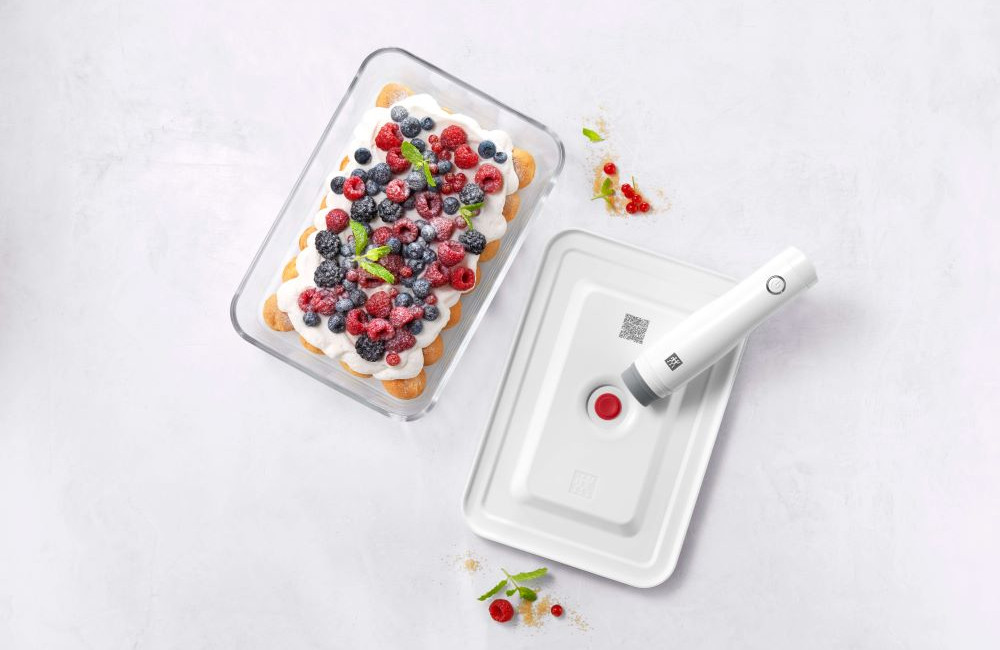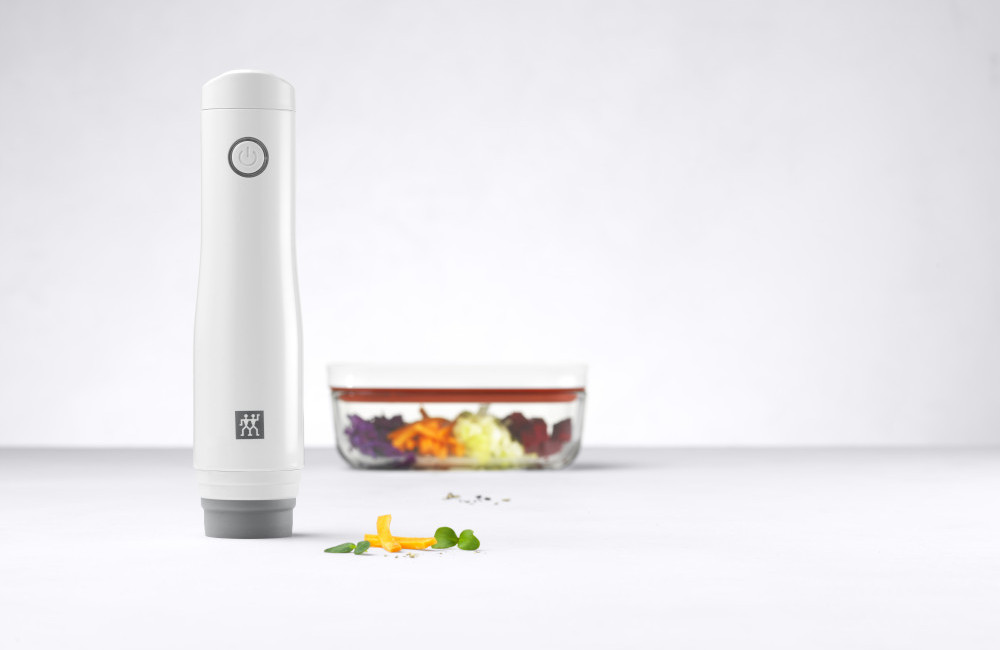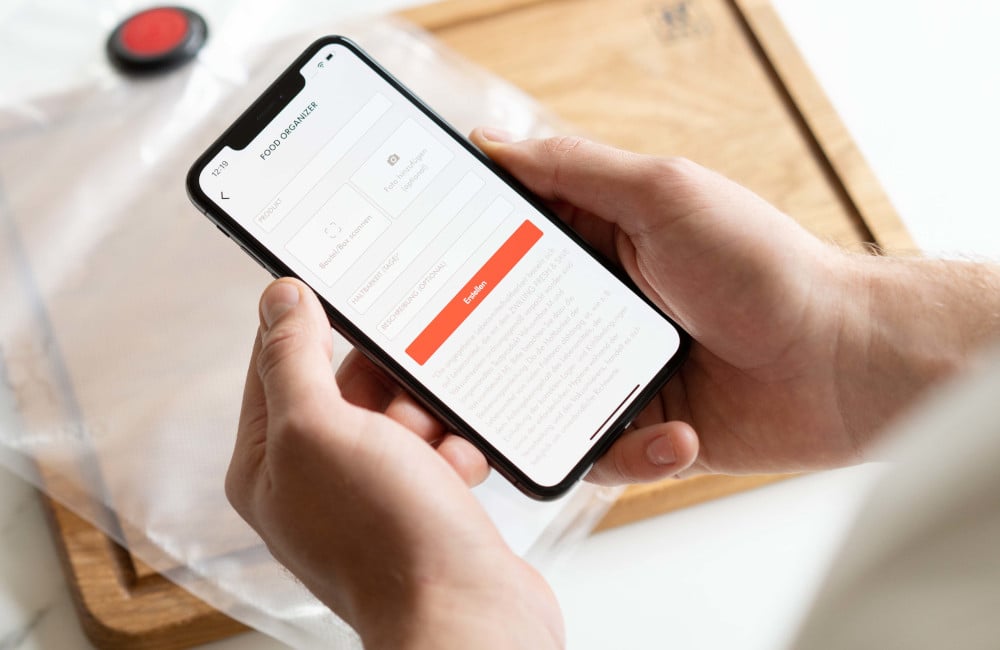



O ciclo de vida dos alimentos selados a vácuo depende de muitos fatores, incluindo: a contagem inicial de germes dos alimentos, aderência às condições corretas de armazenamento e arrefecimento, e práticas individuais de higiene seguidas durante a preparação e selagem a vácuo. A aplicação ZWILLING Culinary World calcula a longevidade estimada dos alimentos com base no tipo de alimentos armazenados (por exemplo, carne fresca ou vegetais frescos) e no local de armazenamento (por exemplo, frigorífico, congelador ou despensa). Tenha em mente que a longevidade calculada é uma orientação estimada.
Os alimentos devem ser deixados a arrefecer pelo menos até à temperatura ambiente antes da selagem a vácuo. A selagem a vácuo de alimentos quentes não é geralmente recomendada. Os produtos FRESH & SAVE não oferecem isolamento e, portanto, não manterão os alimentos quentes.
Todos os componentes utilizados na produção de produtos FRESH & SAVE são de qualidade alimentar e verificados quanto à presença de substâncias nocivas.
A ZWILLING oferece uma garantia de 2 anos na bomba e recipientes FRESH & SAVE.
A selagem a vácuo não é um substituto para a congelação, arrefecimento ou armazenamento correto dos alimentos. Dependendo do tipo de alimento, as práticas de armazenamento padrão geralmente recomendadas devem ser seguidas.
A selagem a vácuo extrai o ar que envolve os alimentos num recipiente, reduzindo assim acentuadamente o teor de oxigénio do recipiente e retardando os processos de oxidação e aeróbicos. Tal resulta numa deterioração mais lenta dos alimentos. Além disso, a quantidade mínima de ar que ainda está presente após a selagem a vácuo é incapaz de transportar humidade para o ambiente circundante, ajudando a evitar as queimaduras do congelador e a preservar os sabores por mais tempo.
A tampa do recipiente especialmente concebida também serve como um indicador de selagem a vácuo. Se a tampa estiver afundada, existe um vácuo no interior do recipiente. Se a tampa estiver ligeiramente elevada, o vácuo deve ser renovado. Recomenda-se que verifique o vácuo de vez em quando, particularmente quando armazenar alimentos a longo prazo.
Quanto menos vezes um alimento entrar em contacto com o ar, mais tempo permanecerá fresco. Ao abrir regularmente um recipiente ou saco, este deve ser novamente selado a vácuo o mais rapidamente possível após a abertura.

A bomba foi especialmente concebida para o sistema de vácuo FRESH & SAVE. Esta é a única forma de garantir os melhores resultados de selagem a vácuo.
Não.
Tanto a bomba de vácuo como a bateria estão cobertas por uma garantia de 2 anos.
Não. A bomba é alimentada por uma bateria integrada que pode ser carregada utilizando o cabo USB incluído.
Evite absorver líquidos para dentro da bomba. Pare imediatamente o processo de selagem a vácuo se notar que algum líquido está a ser aspirado para a bomba. Se o líquido entrar acidentalmente na bomba, desligue a bomba e abane-a levemente. Se aspirou uma quantidade de líquido que não lhe permite voltar a ligar a bomba, proceda da seguinte forma: abane ligeiramente a bomba para limpar o líquido. Não a vire para cima! Certifique-se de que a bomba e a unidade de carga estão completamente secas. Em seguida, ligue a bomba à unidade de carregamento durante 1 segundo para a repor. Separe a bomba da unidade de carregamento e prima o botão ON/OFF. Se a bomba continuar a desligar-se, repita este processo.
Não. Devido à bateria integrada, a bomba não pode ser limpa na máquina de lavar louça. Para uma limpeza ligeira, basta limpar a bomba de vácuo com um pano húmido. O acessório de silicone pode ser removido e limpo sob água corrente.

A tampa da caixa especialmente fabricada serve também como um indicador de vácuo. Se a tampa estiver afundada, existe um vácuo dentro da caixa. Se a tampa estiver ligeiramente elevada, o vácuo deve ser renovado. As caixas sem indicador, por exemplo, as lancheiras, não podem ser abertas sob vácuo. Se a tampa puder ser aberta sem muito esforço, o vácuo deve ser renovado. Particularmente quando se armazenam alimentos a longo prazo, recomenda-se que se verifique o vácuo de vez em quando, por exemplo, quando produtos como o Parmesão são mantidos no frigorífico.
As caixas são feitas para o contacto a longo prazo com alimentos e são verificadas quanto à segurança alimentar e substâncias nocivas.
Sim.
Não, as caixas de plástico não são adequadas para utilização no forno. A caixa e a tampa são resistentes ao calor até 97 °C.
Todas as caixas e tampas podem ser utilizadas no micro-ondas. No entanto, é importante que primeiro se liberte o vácuo das caixas. Para alimentos gordurosos, recomendamos a utilização das caixas de vidro FRESH & SAVE.
É um vidro excecionalmente resistente ao calor que resiste tanto a temperaturas quentes como frias. Devem ser evitadas as flutuações de altas temperaturas.
Não, para evitar o choque térmico, os recipientes não podem ser colocados diretamente do frio para o calor.
O vidro borossilicato é muito resistente ao calor, o que permite que as caixas de vidro sejam limpas a todas as temperaturas na máquina de lavar louça.
Não.
Não é possível descartar a possibilidade de que os corantes alimentares fortes, tais como os da beterraba ou curcuma, possam deixar vestígios de cor.
Em princípio, sim. No entanto, é possível que, por exemplo, marinadas de sabor intenso possam deixar vestígios de odor. Estes podem ser eliminados limpando com vinagre e depois lavando novamente à mão ou na máquina de lavar louça.
Sim, as caixas precisam de cerca de 1 a 2 centímetros de espaço a partir do topo para permitir que a tampa assente corretamente e impedir que o conteúdo entre em contacto com a válvula.

Em caso de rasgões ou componentes soltos, tais como o fecho já não selar corretamente, interrompa o uso. Pode utilizar os sacos até que note que já não fecham corretamente ou se não conseguirem manter o vácuo. Se a bomba já não parar automaticamente, isto pode ser um sinal de que o saco tem um buraco ou que já não fecha corretamente.
Após uma lavagem completa com água quente e detergente, os sacos de vácuo devem ser bem secos. Podem ser reutilizados. É possível que, por exemplo, marinadas de sabor intenso deixem vestígios de odor no saco ou que o mesmo seja colorido por alguns alimentos.
Tal depende da utilização individual.
Sim, os sacos podem ser utilizados em micro-ondas para aquecer o seu conteúdo, desde que este não seja gorduroso. Para comida gordurosa, recomendamos a utilização de caixas de vidro FRESH & SAVE. Assegure-se de libertar primeiro o vácuo.
Não, os sacos são apenas adequados para utilização em micro-ondas e para cozinhar em sous-vide.
Sim, pequenas porções no saco de vácuo tamanho S podem ser aquecidas na Chaleira elétrica ENFINIGY Pro a uma temperatura máxima de 80 °C.
Não. Isto pode danificar a integridade estrutural do saco.
Sim, os sacos são adequados para líquidos. As seguintes dicas podem ajudar:
• Congele ligeiramente o conteúdo de antemão
• Suspenda o saco sobre a borda da mesa para que o líquido não chegue à válvula.
• Para quantidades pequenas de líquidos, tais como marinadas, utilize a «barreira líquida»
Em princípio, sim. No entanto, é possível que, por exemplo, marinadas de sabor intenso possam deixar vestígios de odor.
Os sacos devem ser enchidos não mais do que um pouco abaixo da válvula.
Não é possível descartar a possibilidade de que os corantes alimentares fortes, tais como os da beterraba ou curcuma, possam deixar vestígios de cor.

É geralmente adequado para todas as bebidas, sumos e mesmo óleos e vinagres. No entanto, não é adequado para líquidos gaseificados.
O selador de vinho adapta-se a todos os gargalos de garrafas, normalizados pela norma europeia (17-19 mm de diâmetro interior). Esta norma é também aplicável em países estrangeiros

Sim, uma vez instalada a aplicação ZWILLING Culinary World, é possível ver todas as receitas com antecedência e encontrar sugestões.
Nesses casos, não é selecionado nenhum grupo alimentar ou é selecionado o grupo alimentar mais semelhante. A validade também pode ser definida individualmente.
Sim.
Sim.
Sim, no website da ZWILLING.
A aplicação utiliza notificações push para lembrar que a data de validade recomendada foi alcançada ou ultrapassada. Os itens digitalizados não são automaticamente apagados. Tal deve ser feito pelo utilizador.